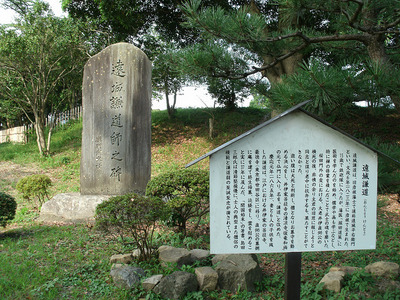Difference between revisions of "Onjo Kendo"
| (One intermediate revision by the same user not shown) | |||
| Line 1: | Line 1: | ||
| + | [[File:Onjo-kendo.jpg|right|thumb|400px|Monument to Onjô Kendô at [[Hikone castle]]]] | ||
*''Born: [[1823]]'' | *''Born: [[1823]]'' | ||
*''Died: [[1910]]'' | *''Died: [[1910]]'' | ||
| Line 10: | Line 11: | ||
After the [[Sakuradamongai Incident]] in which his lord [[Ii Naosuke]] was killed, Onjô felt a deep sense of loyalty, and wished to devote himself further to his lord in some fashion. Feeling that following his lord in death by [[junshi|committing seppuku]] was "a dog's death," however, he decided to instead become a monk and devote himself to watching over Naosuke's grave. He became a disciple of the head of [[Seiryo-ji|Seiryô-ji]], the [[Ii clan]] [[bodaiji|family temple]], and took on the monastic name Kendô. | After the [[Sakuradamongai Incident]] in which his lord [[Ii Naosuke]] was killed, Onjô felt a deep sense of loyalty, and wished to devote himself further to his lord in some fashion. Feeling that following his lord in death by [[junshi|committing seppuku]] was "a dog's death," however, he decided to instead become a monk and devote himself to watching over Naosuke's grave. He became a disciple of the head of [[Seiryo-ji|Seiryô-ji]], the [[Ii clan]] [[bodaiji|family temple]], and took on the monastic name Kendô. | ||
| − | In [[1865]], he moved to [[Edo]], leaving behind a wife and six children, and took up a position at the Ii clan temple of [[Gotoku-ji|Gôtoku-ji]], where he devoted himself to watching over Naosuke's grave, tidying and cleaning the cemetery, reciting sutras, and other such activities, for the next 37 years. | + | In [[1865]], he moved to [[Edo]], leaving behind a wife and six children, and took up a position at the Ii clan temple of [[Gotoku-ji|Gôtoku-ji]], where he devoted himself to watching over Naosuke's grave, tidying and cleaning the cemetery, reciting sutras, and other such activities, for the next 37 years. After his death in [[1910]], gravestones were erected for Onjô both at Gôtoku-ji and at Hikone castle, next to those for Naosuke. |
{{stub}} | {{stub}} | ||
| Line 16: | Line 17: | ||
==References== | ==References== | ||
*Plaques on-site at Hikone castle.[https://www.flickr.com/photos/toranosuke/8717008193/sizes/k/] | *Plaques on-site at Hikone castle.[https://www.flickr.com/photos/toranosuke/8717008193/sizes/k/] | ||
| + | *[[Haru Matsukata Reischauer]], ''Samurai and Silk: A Japanese and American Heritage'', Harvard University Press (1986), 171-172. | ||
[[Category:Bakumatsu]] | [[Category:Bakumatsu]] | ||
[[Category:Religious Figures]] | [[Category:Religious Figures]] | ||
[[Category:Samurai]] | [[Category:Samurai]] | ||
Latest revision as of 14:21, 10 February 2018

Onjô Kendô was a samurai scholar and Buddhist monk known for his exceptional devotion to his lord, Ii Naosuke.
Born into a low-ranking samurai family in Hikone in 1823, Onjô Heiemon entered the domain's gunnery squad at the age of 15, but soon afterwards began studying medicine under a domain physician. He also studied painting, Confucianism, and Zen practice.
After the Sakuradamongai Incident in which his lord Ii Naosuke was killed, Onjô felt a deep sense of loyalty, and wished to devote himself further to his lord in some fashion. Feeling that following his lord in death by committing seppuku was "a dog's death," however, he decided to instead become a monk and devote himself to watching over Naosuke's grave. He became a disciple of the head of Seiryô-ji, the Ii clan family temple, and took on the monastic name Kendô.
In 1865, he moved to Edo, leaving behind a wife and six children, and took up a position at the Ii clan temple of Gôtoku-ji, where he devoted himself to watching over Naosuke's grave, tidying and cleaning the cemetery, reciting sutras, and other such activities, for the next 37 years. After his death in 1910, gravestones were erected for Onjô both at Gôtoku-ji and at Hikone castle, next to those for Naosuke.
References
- Plaques on-site at Hikone castle.[1]
- Haru Matsukata Reischauer, Samurai and Silk: A Japanese and American Heritage, Harvard University Press (1986), 171-172.